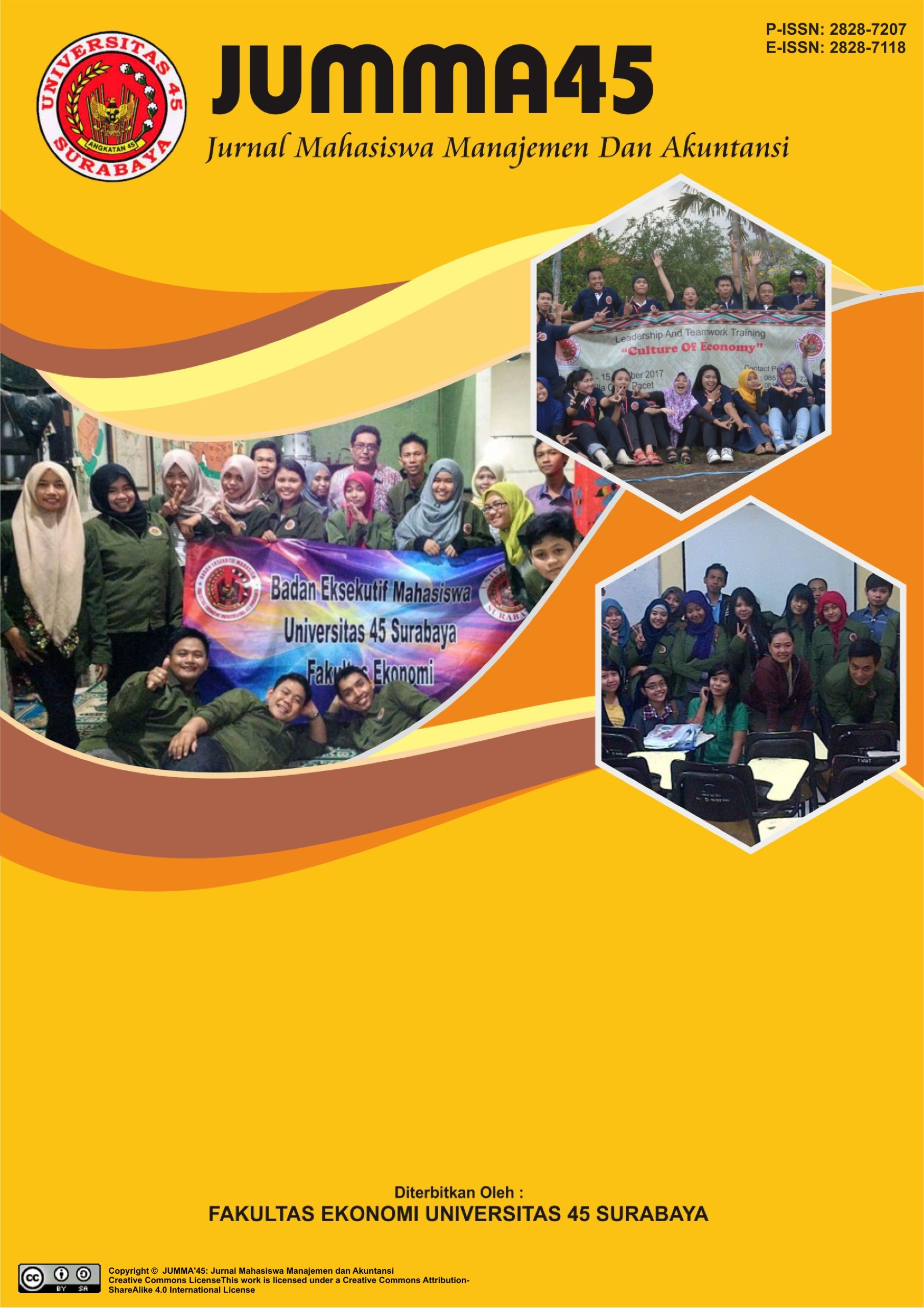Determinasi Pengungkapan Key Audit Matters: Perspektif Teori Audit Expectation Gap
DOI:
https://doi.org/10.30640/jumma45.v4i1.4228Keywords:
Audit Expectation Gap, Key Audit Matters, auditor characteristics, company characteristics, corporate governanceAbstract
This study aims to explore the factors influencing the disclosure of Key Audit Matters (KAM) in audit reports, using the Audit Expectation Gap Theory as a theoretical framework. Based on a literature review of 15 articles published between 2020 and 2025, it was found that factors such as company characteristics (size and complexity), auditor characteristics (experience and specialization), and corporate governance significantly influence the quality and quantity of Key Audit Matters disclosure. Larger and more complex companies tend to disclose more Key Audit Matters, while auditors from large firms provide more detailed disclosures. Furthermore, disclosures that are too generic or use overly formal and non-specific language risk exacerbating the expectation gap. Therefore, it is essential for regulators and auditors to continually improve guidelines and evaluate the implementation of Key Audit Matters to meet transparency and accountability goals.
References
Abu, A., & Jaffar, R. (2020). Audit Committee Effectiveness and Key Audit Matters. Asian Journal of Accounting and Governance, 14(December), 1–12. https://doi.org/10.17576/ajag-2020-14-06
Adams, R. B., & Ferreira, D. (2009). Women in the boardroom and their impact on governance and performance. Journal of financial economics, 94(2), 291-309.
Al Lawati, H., & Hussainey, K. (2022). The Determinants and Impact of Key Audit Matters Disclosure in the Auditor’s Report. International Journal of Financial Studies, 10(4), 107. https://doi.org/10.3390/ijfs10040107
Barua, A., Hossain, M. S., & Rama, D. V. (2019). Financial versus operating liability leverage and audit fees. International Journal of Auditing, 23(2), 231-244. https://doi.org/10.1111/ijau.12157
Carson, (2009). Industry specialization by global audit firm networks. The Accounting Review, 84(2), 355-382. https://doi.org/10.2308/accr.2009.84.2.355
Carson, E., & Fargher, N. (2007). Note on audit fee premiums to client size and industry specialisation. Accounting & Finance, 47(3), 423-446. https://doi.org/10.1111/j.1467- 629x.2007.00213.x
Carson, E., Fargher, N., Simon, D. T., & Taylor, M. H. (2004). Audit fees and market segmentation - Further evidence on how client size matters within the context of audit fee models. International Journal of Auditing, 8(1), 79-91. https://doi.org/10.1111/j.1099-1123.2004.00159.x
Dusadeedumkoeng, O., Gandía, J. L., & Huguet, D. (2023). Determinants of key audit matters in Thailand. Journal of Competitiveness, 15(3), 184–206. https://doi.org/10.7441/joc.2023.03.10
Hussin, N., Md. Salleh, M. F., Ahmad, A., & Rahmat, M. M. (2022). The influence of audit firm attributes on KAM disclosures in FTSE100 in Malaysia. Management and Accounting Review, 21(2), 161–182. https://mar.uitm.edu.my/images/Vol-21-2/10.pdf or https://doi.org/10.24191/MAR.V21i02-10
International Auditing and Assurance Standards Board (IAASB). (2015). ISA 701: Communicating key audit matters in the independent auditor’s report. International Federation of Accountants. https://www.ifac.org/system/files/publications/files/ISA-701_0.pdf
Institut Akuntan Publik Indonesia. (2021). Standar Audit (SA) 701: Pengungkapan hal-hal utama dalam laporan auditor independen. Komite Standar Profesional Akuntan Publik (KSPAP). https://iaiglobal.or.id/v03/standar-akuntan-publik/sa-701
Jensen, M.C., Meckling, W.H., 1976. Theory of the firm: Managerial behavior, agency costs and ownership structure. J. Financ. Econ. 3 (4), 305–360.
Jiang, Ying and Olesen, Karin, Determinants of Key Audit Matter Disclosures: New Zealand Evidence (August 12, 2022). The University of Auckland Business School Research Paper, Available at SSRN: Determinants of Key Audit Matter Disclosures: New Zealand Evidence or http://dx.doi.org/10.2139/ssrn.4675221
Llave, R. de la, & Department. (2022). A tutorial on KAM theory Rafael de la Llave. Proofs.
Mnif, Y., Znazen, O., 2020. Corporate governance and compliance with IFRS 7: The case of financial institutions listed in Canada. Manag. Audit. J. 35 (3), 448–474.
Pfeffer, J. and Salancik, G. (1978) The External Control of Organizations: A Resource Dependence Perspective. Harper & Row, New York.
Pinto, I., & Morais, A. I. (2019). What matters in disclosures of key audit matters: Evidence from Europe. Journal of International Financial Management & Accounting, 30(2), 145–162. https://doi.org/10.1111/jifm.12095
Porter, B, (1993). An Empirical Study of the Audit Expectation-Performance Gap. Accounting and Business Research, 24(93), 49–68. https://doi.org/10.1080/00014788.1993.9729463
Qadrina, M. F., & Raharja, S. (2024). Analisis faktor-faktor yang memengaruhi pengungkapan Key Audit Matters di Indonesia. Jurnal Ilmiah Wahana Akuntansi, 19(1), 67–83. https://doi.org/10.21009/wahana.19.015
Rahaman, M. M., & Karim, M. R. (2023). How do board features and auditor characteristics shape key audit matters disclosures? Evidence from emerging economies. China Journal of Accounting Research, 16(4). https://doi.org/10.1016/j.cjar.2023.100331
Sierra-García, L., Gambetta, N., García-Benau, M. A., & Orta-Pérez M. (2019). Understanding the determinants of the magnitude of entity-level risk and account level risk key audit matters: The case of the United Kingdom. The British Accounting Review, 51(3), 227-240. https://doi.org/10.1016/j.bar.2019.02.004
Sultana, N., Singh, H., Rahman, A., 2019. Experience of audit committee members and audit quality. Eur. Account. Rev. 28 (5), 947–975.
Velte, P., & Issa, J. (2019). The impact of key audit matter (KAM) disclosure in audit reports on stakeholders’ reactions: A literature review. Problems and Perspectives in Management, 17(3), 323–341. https://doi.org/10.21511/ppm.17(3).2019.26
Yoga, B., & Dinarjito, A. (2021). the Impact of Key Audit Matters Disclosure on Communicative Value of the Auditor’S Report: a Systematic Literature Review. Jurnal Akuntansi Dan Keuangan Indonesia, 18(1), 15–32. https://doi.org/10.21002/jaki.2021.02
Downloads
Published
How to Cite
Issue
Section
License
Copyright (c) 2025 Jurnal Mahasiswa Manajemen dan Akuntansi

This work is licensed under a Creative Commons Attribution-ShareAlike 4.0 International License.








